Optimal Beamwidth for Maximizing Uplink Coverage Probability in Quasi Earth-Fixed LEO Satellite Communication System
Abstract
:1. Introduction
- Quasi earth-fixed cells (QEFC): satellites can compensate and steer the beams at the same position on the earth while satellites move.
- Earth-moving cells (EMC): satellites cannot provide steerable beams. The position of beams changes while satellites move.
2. System Model
3. Optimal Beamwidth Maximizing Uplink Coverage Probability Scheme
3.1. Beam Boresight Direction
3.2. Uplink Coverage Probability Analysis Model
3.3. Beamwidth Optimization
| Algorithm 1 Optimal Beamwidth Maximizing Uplink Coverage Probability Scheme |
Input: Beam position on Earth , satellite hight h, and time t Output: Beam boresight direction , , and optimal equivalent antenna aperture
|
4. Numerical Results and Discussion
- 3GPP setting: the equivalent antenna aperture is 2 m, the max receive antenna gain is 30 dBi, and the half-power beamwidth is [18].
- 3GPP setting with three-color frequency reuse (FRF3): The frequency band is divided into three sub-bands, and the adjacent beams are allocated to different sub-bands. Other assumptions follow the 3GPP setting. The three-color frequency reuse is also known as frequency reuse factor three.
- Exhaustive antenna aperture search: exhaustively search the equivalent antenna aperture with the highest uplink coverage probability in a predefined target SINR for each simulated time. The exhaustive antenna aperture search denotes the upper bound of the uplink coverage probability for non-frequency reuse.
4.1. Signal Quality
4.2. Uplink Coverage Probability
5. Conclusions
Author Contributions
Funding
Data Availability Statement
Acknowledgments
Conflicts of Interest
Abbreviations
| 3GPP | Third-Generation Partnership Project |
| 5G | Fifth-Generation mobile network |
| ECEF | Earth-Centered Earth-Fixed |
| EMC | Earth-moving cells |
| FRF3 | Three-color frequency reuse |
| FSPL | Free-space path loss |
| LEO | Low earth orbit |
| LOS | Line-of-sight |
| NLOS | Non-line-of-sight |
| NR | New Radio |
| NTN | Non-terrestrial networks |
| PUSCH | Physical uplink shared channel |
| QEFC | Quasi earth-fixed cells |
| SINR | Signal-to-interference-plus-noise ratio |
| UE | User equipment |
| VoNR | Voice-over New Radio |
References
- Liao, Q.; Kaneko, M. Global Energy Efficiency Optimization of a Ka-Band Multi-Beam LEO Satellite Communication System. IEEE Access 2021, 9, 55232–55243. [Google Scholar] [CrossRef]
- Measuring Digital Development: Facts and Figures 2022. Available online: https://www.itu.int/hub/publication/d-ind-ict_mdd-2022/ (accessed on 1 April 2024).
- Xia, S.; Jiang, Q.; Zou, C.; Li, G. Beam Coverage Comparison of LEO Satellite Systems Based on User Diversification. IEEE Access 2019, 7, 181656–181667. [Google Scholar] [CrossRef]
- Juan, E.; Lauridsen, M.; Wigard, J.; Mogensen, P. Performance Evaluation of the 5G NR Conditional Handover in LEO-based Non-Terrestrial Networks. In Proceedings of the 2022 IEEE Wireless Communications and Networking Conference (WCNC), Austin, TX, USA, 10–13 April 2022. [Google Scholar] [CrossRef]
- Darwish, T.; Kurt, G.K.; Yanikomeroglu, H.; Bellemare, M.; Lamontagne, G. LEO Satellites in 5G and Beyond Networks: A Review From a Standardization Perspective. IEEE Access 2022, 10, 35040–35060. [Google Scholar] [CrossRef]
- 3GPP R2-2313877. RACH-less satellite switch procedure. In Proceedings of the 3GPP TSG RAN WG2 Meeting #124, Chicago, IL, USA, 13–17 November 2023. [Google Scholar]
- Yu, J.; Kim, J.H. Analysis of SINR according to Elevation Angle in Earth Fixed Beam. In Proceedings of the 2022 27th Asia Pacific Conference on Communications (APCC), Jeju Island, Republic of Korea, 19–21 October 2022. [Google Scholar] [CrossRef]
- Baik, J.S.; Kim, J.H. Analysis of the Earth Fixed Beam Duration in the LEO. In Proceedings of the 2021 International Conference on Information Networking (ICOIN), Jeju Island, Republic of Korea, 13–16 January 2021. [Google Scholar] [CrossRef]
- Yi, J.; Kim, Y.; Ryu, H. Performance of Uplink Coverage Enhancement Schemes for 5G NR in 3GPP. In Proceedings of the 2022 IEEE 95th Vehicular Technology Conference: (VTC2022-Spring), Helsinki, Finland, 19–22 June 2022. [Google Scholar] [CrossRef]
- Nasarre, I.P.; Levanen, T.; Pajukoski, K.; Lehti, A.; Tiirola, E.; Valkama, M. Enhanced Uplink Coverage for 5G NR: Frequency-Domain Spectral Shaping With Spectral Extension. IEEE Open J. Commun. Soc. 2021, 2, 1188–1204. [Google Scholar] [CrossRef]
- 3GPP R1-2208321. Final Report of 3GPP TSG RAN WG1 #110 v1.0.0. In Proceedings of the 3GPP TSG RAN WG1 Meeting #110bis-e, Online Meeting, 10–19 October 2022. [Google Scholar]
- 3GPP R1-2207811. Summary #4 on 9.12.1 Coverage enhancement for NR NTN. In Proceedings of the 3GPP TSG RAN WG1 Meeting #110, Toulouse, France, 22–26 August 2023. [Google Scholar]
- Vázquez, M.Á.; Pérez-Neira, A.; Christopoulos, D.; Chatzinotas, S.; Ottersten, B.; Arapoglou, P.; Ginesi, A.; Taricco, G. Precoding in Multibeam Satellite Communications: Present and Future Challenges. IEEE Wirel. Commun. 2016, 23, 88–95. [Google Scholar] [CrossRef]
- Spacex Non-Geostationary Satellite System Attachment a Technical Information to Supplement Schedule S. November 2016. Available online: https://fcc.report/IBFS/SAT-LOA-20161115-00118/1158350 (accessed on 1 April 2024).
- Al Homssi, B.; Al-Hourani, A. Optimal Beamwidth and Altitude for Maximal Uplink Coverage in Satellite Networks. IEEE Wirel. Commun. Lett. 2022, 11, 771–775. [Google Scholar] [CrossRef]
- 3GPP TR 38.811. Study on New Radio (NR) to Support Non-Terrestrial Networks (Release 15). V15.4.0, September 2020. Available online: https://portal.3gpp.org/desktopmodules/Specifications/SpecificationDetails.aspx?specificationId=3234 (accessed on 1 April 2024).
- 3GPP R1-2208321. Discussion on NR NTN coverage enhancement. In Proceedings of the 3GPP TSG RAN WG1 Meeting #110, Toulouse, France, 22–26 August 2023. [Google Scholar]
- 3GPP TR 38.821. Solutions for NR to Support Non-Terrestrial Networks (NTN) (Release 16). V16.1.0, May 2021. Available online: https://portal.3gpp.org/desktopmodules/Specifications/SpecificationDetails.aspx?specificationId=3525 (accessed on 1 April 2024).
- 3GPP RP-222654. Revised WID: NR NTN (Non-Terrestrial Networks) enhancements. In Proceedings of the 3GPP TSG RAN Meeting #97-e, Online Meeting, 12–16 September 2022. [Google Scholar]

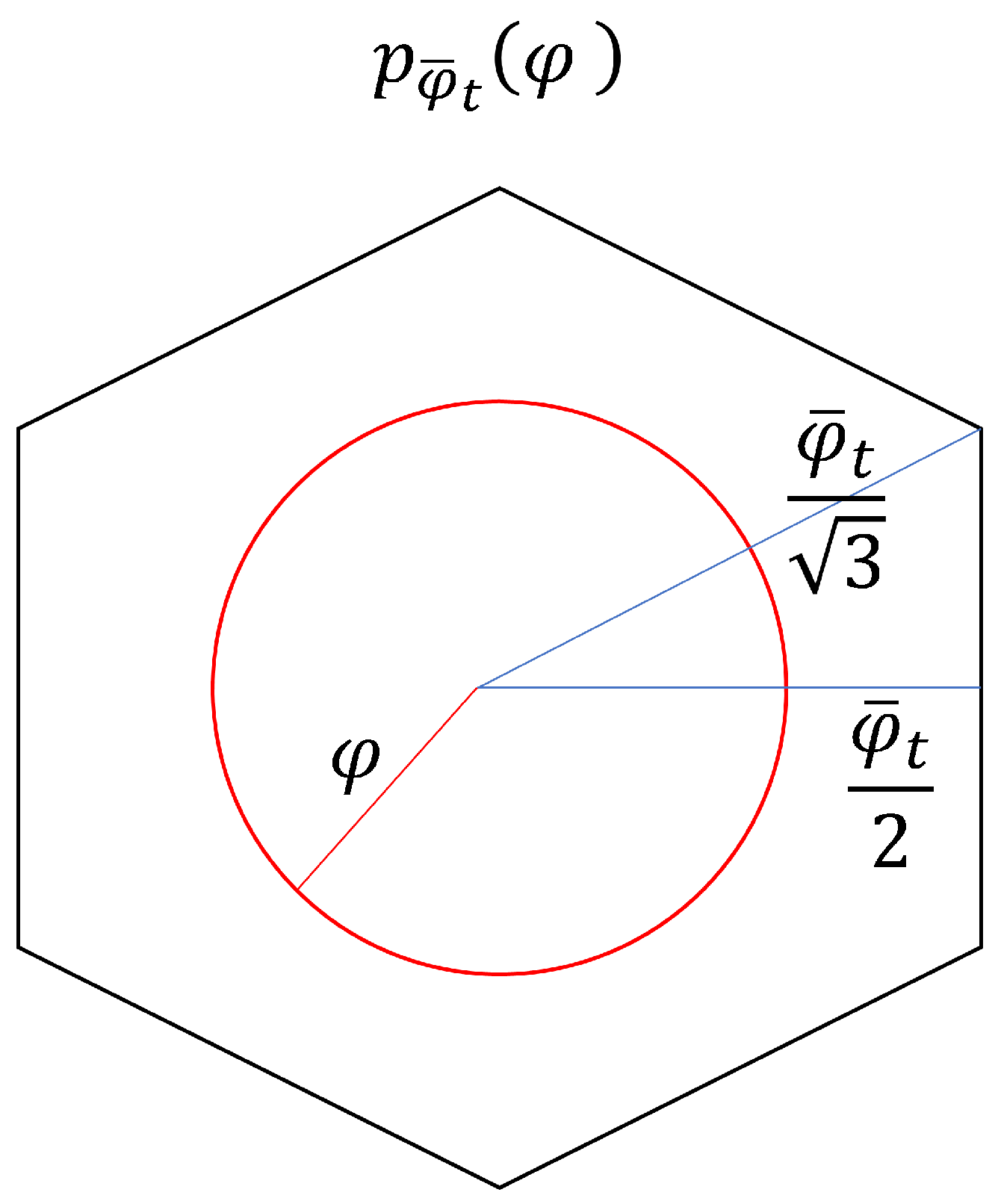

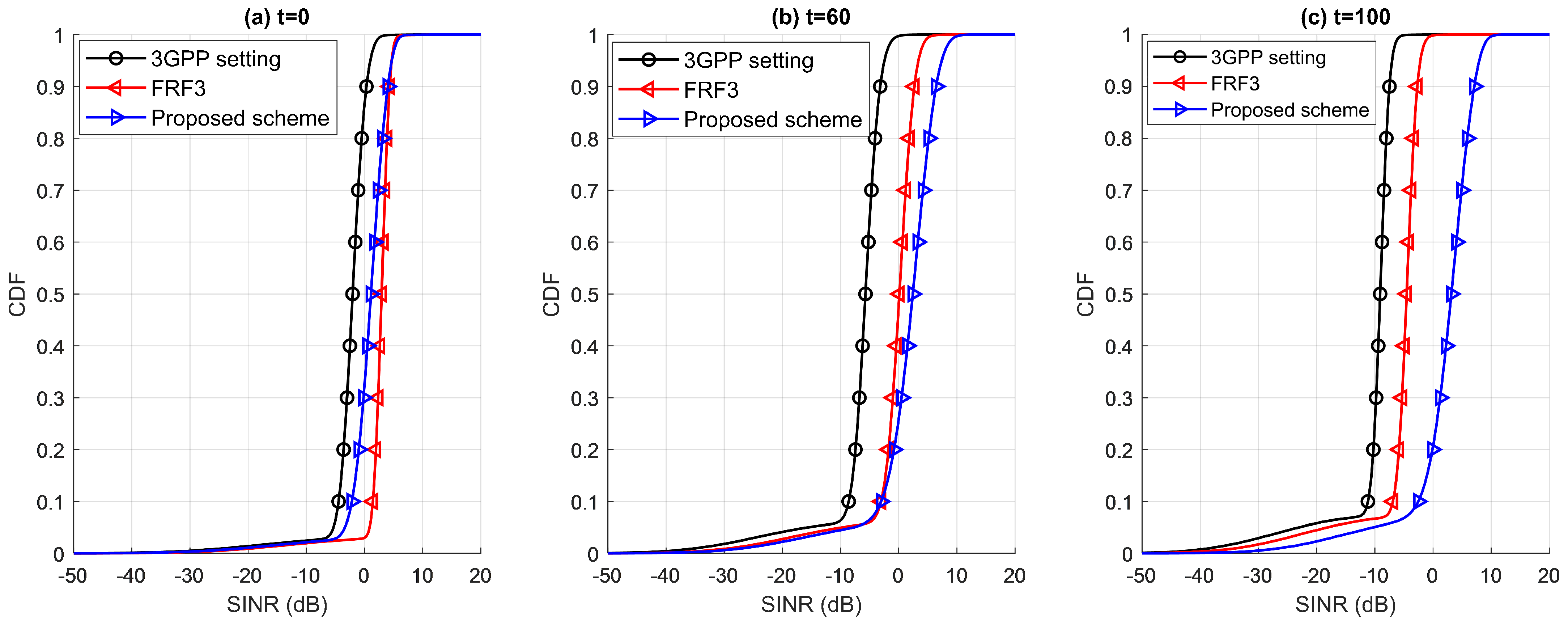

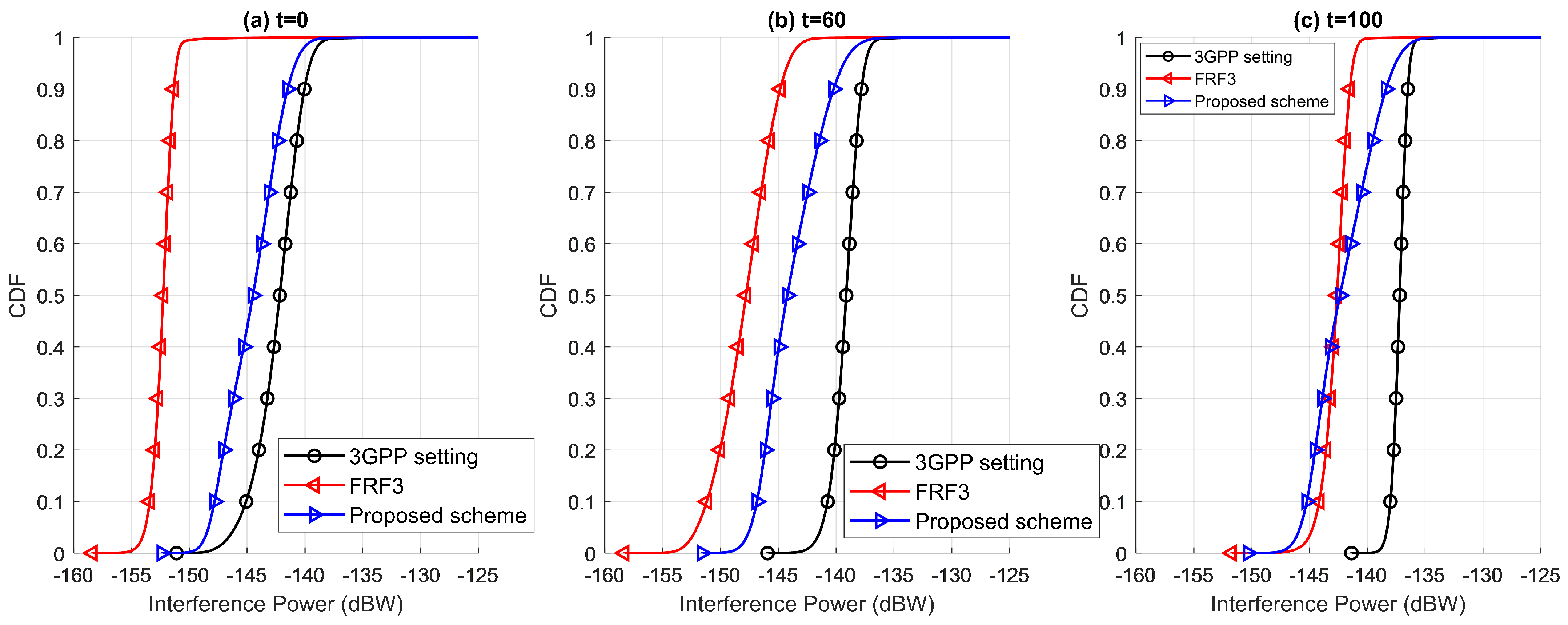



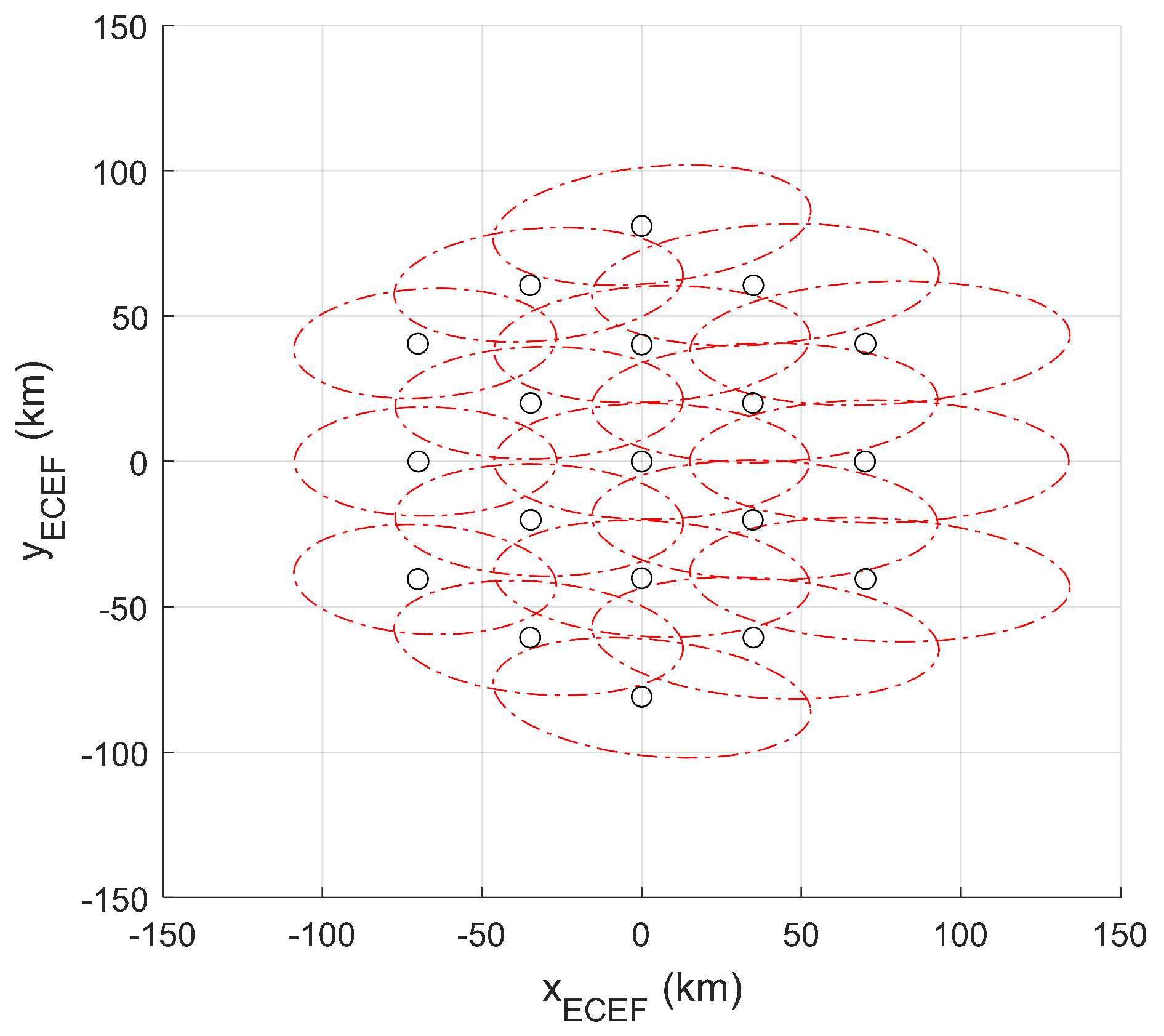

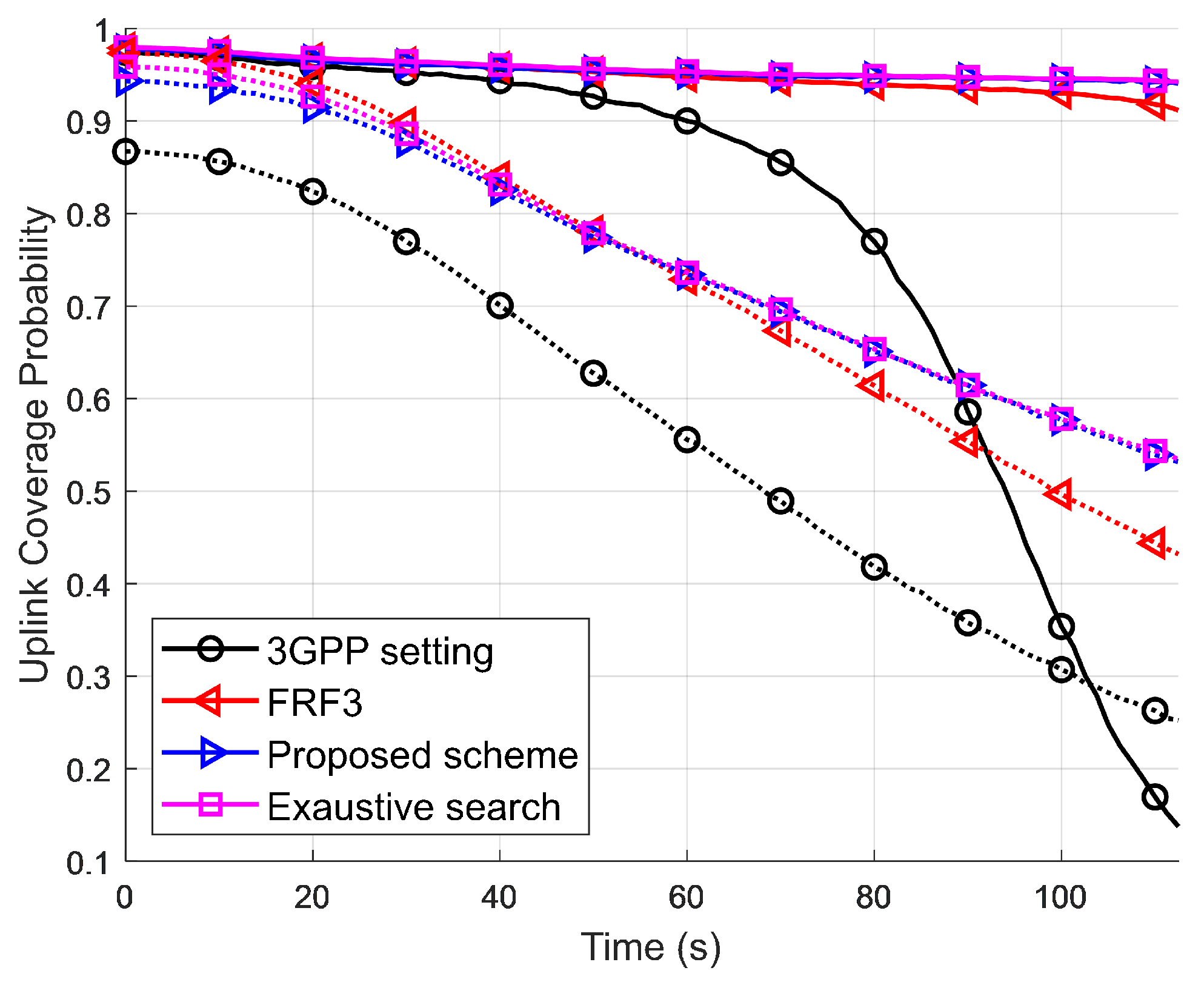
| Notation | Distriptions |
|---|---|
| The set of the simulated frequency band and time. for FRF3 and for non-frequency reuse. | |
| The set of beams in frequency band f (), UE serving by beam l (). | |
| Elevation angle of beam l, elevation angle of user s served by beam l. | |
| Clutter loss. Clutter loss is 0 for the LOS state. The values for the (NLOS state at elevation angle are defined in [16]. | |
| Shadow fading at elevation angle . Shadow fading is zero mean Gaussian variable. | |
| The variation in shadow fading for lien-of-sight (LOS) and non line-of-sight (NLOS) states at elevation angle [16]. | |
| LOS probability and NLOS probability at elevation angle [16]. | |
| Angle difference of boresight direction between beam l and beam k ( and ). | |
| Angle difference of UE s and boresight direction of beam l. | |
| The probability of the condition x to be satisfied, . |
| Assumption | Value |
|---|---|
| Satellite height | 600 km |
| Satellite beam pattern | 19 spot beams with wrap-around |
| Max antenna gain for 3GPP setting and FRF3 | 30 dBi |
| Carrier frequency | 2 GHz |
| UE-type | Handheld |
| UE antenna configuration | Omni-directional, −5.5 dBi antenna gain [19] |
| UE transmit power | 23 dBm |
| UE attachment | RSRP |
| Scheduled bandwidth | 180 kHz (1 resource block) |
| Noise power | −147 dBW |
Disclaimer/Publisher’s Note: The statements, opinions and data contained in all publications are solely those of the individual author(s) and contributor(s) and not of MDPI and/or the editor(s). MDPI and/or the editor(s) disclaim responsibility for any injury to people or property resulting from any ideas, methods, instructions or products referred to in the content. |
© 2024 by the authors. Licensee MDPI, Basel, Switzerland. This article is an open access article distributed under the terms and conditions of the Creative Commons Attribution (CC BY) license (https://creativecommons.org/licenses/by/4.0/).
Share and Cite
Liu, C.-T.; Pan, J.-Y. Optimal Beamwidth for Maximizing Uplink Coverage Probability in Quasi Earth-Fixed LEO Satellite Communication System. Electronics 2024, 13, 1349. https://doi.org/10.3390/electronics13071349
Liu C-T, Pan J-Y. Optimal Beamwidth for Maximizing Uplink Coverage Probability in Quasi Earth-Fixed LEO Satellite Communication System. Electronics. 2024; 13(7):1349. https://doi.org/10.3390/electronics13071349
Chicago/Turabian StyleLiu, Chun-Tai, and Jen-Yi Pan. 2024. "Optimal Beamwidth for Maximizing Uplink Coverage Probability in Quasi Earth-Fixed LEO Satellite Communication System" Electronics 13, no. 7: 1349. https://doi.org/10.3390/electronics13071349






